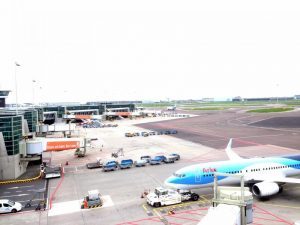Travel Logistics
Becoming a savvy traveler and knowing how to work the various systems to get the best deal doesn’t happen overnight. But you have to start somewhere.
One of the first steps is to obtain a passport. If you already have one, you can skip this paragraph, but I’m betting that some of you don’t have one yet. Passports are required if you wish to travel outside of your country of origin. The exception to this rule is if you are a citizen of a country that participates in the Schengen Agreement, in which case you can travel to other Schengen countries with just your national identity card. Passports are not just useful for traveling; they act as a second piece of government-issued documentation verifying your identity. Even if you don’t plan on traveling abroad, I would still highly suggest applying for one. Be advised that it can take between 6-8 weeks to receive once you file the requisite paperwork and that they are valid for 10 years, after which time you’ll have to renew.
The next step in learning how to travel smartly and within your budget is to become familiar with the various internet tools available for free that can assist you in your searches. While each airline has its own search tool, which may or may not list flights with partner airlines, there are a few sites that will perform a multi-site search. Kayak is a great tool for domestic and international airline searches. It can also search for hotels and rental cars. The ITA Matrix is another website, which many frequent flyers prefer, that will search for flights. It’s one of the most comprehensive tools out there for flight searches, but you cannot book flights with it. Once you find a flight you like, you have to use another website—either Kayak, Travelocity, Orbitz, or the airline directly—to purchase the tickets.
One of the main goals of traveling and earning frequent flyer miles is to earn free flights. And you do have to earn them; they aren’t given to you. If you already have a particular airline with which you earn frequent flyer miles, you should stick with that particular alliance, whether it’s Star Alliance, Skyteam, or oneworld. Starting from scratch with another alliance can seem defeatist in some ways. But if you know you’ll be taking many flights with a particular alliance or if you take a couple of business/first class flights within a calendar year, you can build up miles and elite status relatively quickly. Otherwise, I would suggest maintaining your loyalty to the airline you already fly.
If you don’t already have a loyalty to a particular alliance, there are several factors to consider when choosing one. First, are you traveling outside the U.S.? If not, you can pick an airline at will. If you are, you need to know in which regions each airline specializes. For example, United has more flights to Asia, American has more flights to Central and South America, and Delta flies to many cities in Europe and Asia. While no airline excludes a particular region, a quick search of airline route maps will give you a better idea which airline is better for you.
Second, do you have a co-branded credit card with any airline currently? If so, you are most likely already earning miles thru your purchases and should continue doing so. If you don’t have one, this is a must-have to make the most out of your daily purchases. There’s no reason not to earn miles, even if it is a 1:1 match, for the purchases you are going to make anyway. Some credit cards offer a 2:1 match for certain purchase categories, such as gas, groceries, and airline tickets. For example, if you have the American Express Delta Skymiles card, any purchases done on Delta’s website for Delta or Delta-coded flights earn you 2 miles for every 1 dollar spent. This is in addition to the actual miles you earn by taking the trip. If you bought a Delta business class ticket from the U.S. to Europe for around $2,500 and put it on your Delta co-branded American Express, you would not only earn the approximately 10,000 miles for the actual trip, but another 5,000 miles just for using that card.
There are some credit cards that let you earn reward points which can be transferred to various airlines or redeemed for credit on your credit card statement. These can be beneficial if you don’t have a credit card that earns you double miles on airline tickets purchased directly with airlines.
Most of the major airlines also have online shopping malls through which you can make purchases, earning you even more points. If you keep up to date with their monthly specials for bonus miles, purchases you would have made anyway can bring in the points quickly.
Once you’ve chosen which airline alliance you want to join, the next step is learning how to get free hotel stays. Many hotel chains have loyalty programs, and some even have co-branded credit cards to help you earn points quicker. Similar to airline loyalty, hotel loyalty can earn you free nights. One of the trade-offs with this system, however, is you may be paying more for your hotel nights than is necessary. Sometimes similar quality hotels can be found at a lower price, but in order to earn more loyalty points with a particular hotel, you may have to pay more to stay there.
One way around this is to use a travel site to book your hotels while earning rewards from the site itself, not the specific hotel chain. One way to do this is through hotels.com, which uses a money value instead of a points system. For every 10 nights you stay in hotels, you earn 1 free night equal to the aggregate value of what you’ve paid. For example, if you stay 10 nights in a hotel at $110 per night, you earn 1 night worth $110. This money can be applied to a future stay, even if the next hotel costs more. You will just pay the difference between the two prices for that one night. For us, this system works better than being loyal to a specific hotel chain since we prefer quality hotels at cheaper prices outside of towns. In just 2 years of membership, we have earned 3 free nights and will get a 4th from our next vacation in May. The key to this system, however, is to always redeem your money value in full. Using the above example, if you have $110 available, don’t book a hotel costing less than this. Any unused portion, when redeemed, is forfeited. You also cannot combine 2 free nights to pay for one more expensive night.
Now that you have a specific airline alliance and hotel system chosen, it’s time to book a flight. The cheapest days to fly are Monday-Thursday, but if your vacation time is delimited by calendar weeks, this isn’t an option. But if you are flexible with your travel dates, many websites have a multi-day search function. For example, Kayak will look + or – 3 days of your chosen date. Delta’s online system will look for 5 weeks at a time, but has limitations since it only searches for Delta flights on Delta planes. No co-shared flights will come up in this particular search. Also, if you change the duration of your vacation, the price of your flight may go up or down. Some airlines offer lower prices if you stay over a Saturday night. Some may offer lower pricing on domestic red-eye flights since the airlines know people don’t like taking these since they are usually too short to get a normal amount of sleep, provided you can sleep at all on planes.
There are peak seasons to visit certain regions. Flights to Europe are always more expensive in summer since airline companies take advantage of the fact that people with children in school are most likely to travel only while school isn’t in session. Flights to Japan are most expensive during cherry blossom season, and the airlines play on this knowledge to extract more money. It used to be that booking international airfare was something you had to do well in advance to get the best deals. While this is still true when redeeming reward miles, the best prices are not found that far out now. Current airline philosophy is to offer discounted international fares anywhere between 2 and 4 months out. For domestic flights, lower fares can be found between 4 and 6 weeks out. For the traveler who likes to plan everything, this new system can be frustrating, but it also offers people with more flexible dates the chance to snag low fares.
Once you decide on a destination, one of the biggest mistakes you can make is to lock yourself into a specific airport. I’ve been guilty of this when I first started, but not anymore. If you are traveling to a large city such as NYC, Los Angeles, or Chicago, there are multiple airports from which you can choose. Don’t lock yourself into JFK airport if you want to go to NYC; there is also Newark and LaGuardia airports. One way to avoid this problem is to enter alternate codes into your search engine. For example, input NYC instead of JFK, LGA, or EWR. Enter TYO for Tokyo instead of just NRT or HND. London has 5 airports, all of which have international flights. So enter LON the next time you search flights to London. Some search engines have a radio button to search nearby airports automatically. Don’t be afraid to use it. You may be surprised at what you find.
Another trick I’ve learned over the years is to look at alternative airports when flying to Europe. This may seem counterproductive, but it can save you a lot of money. Flying into the main airports can be expensive, especially London-Heathrow, London-Gatwick, Amsterdam Schiphol, Paris Charles de Gaulle, and Frankfurt. Due to the EU’s deregulation of European airlines, cheap puddlejump flights can be found all over Europe. Instead of the main airports many people use, try flights into Copenhagen, Oslo, Stockholm, Milan, and Barcelona. Yes, it requires backtracking and extra checkins. But it can save you upwards of $500. Our last trip to the Netherlands and Germany would have been over $1,100 round trip per person if we had flown into Amsterdam directly, but we flew into Copenhagen and only paid $650 round trip per person. The short flight between Amsterdam and Copenhagen to return, because we had to fly back to the U.S. From Copenhagen, only cost around $80 per person. Even with the extra flight, we saved over $350, got to visit a city we weren’t planning on seeing, and got extra miles. We are doing the same type of trip in May when we go to Oslo before spending 10 days in the Netherlands. Round trip to Oslo was again around $650 per person, and the round trip between Oslo and Amsterdam was $140. If we had booked directly into Amsterdam, this trip would have been over $1,200 per person. So it clearly pays to search alternative airports.
 So what is the difference between non-stop, direct, and connecting flights? And why does this matter?
So what is the difference between non-stop, direct, and connecting flights? And why does this matter?

